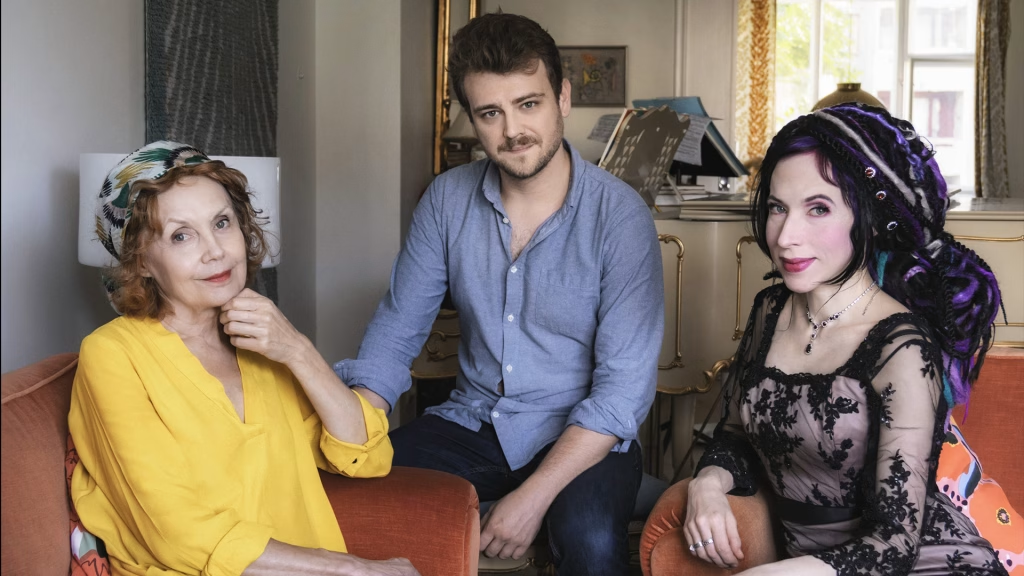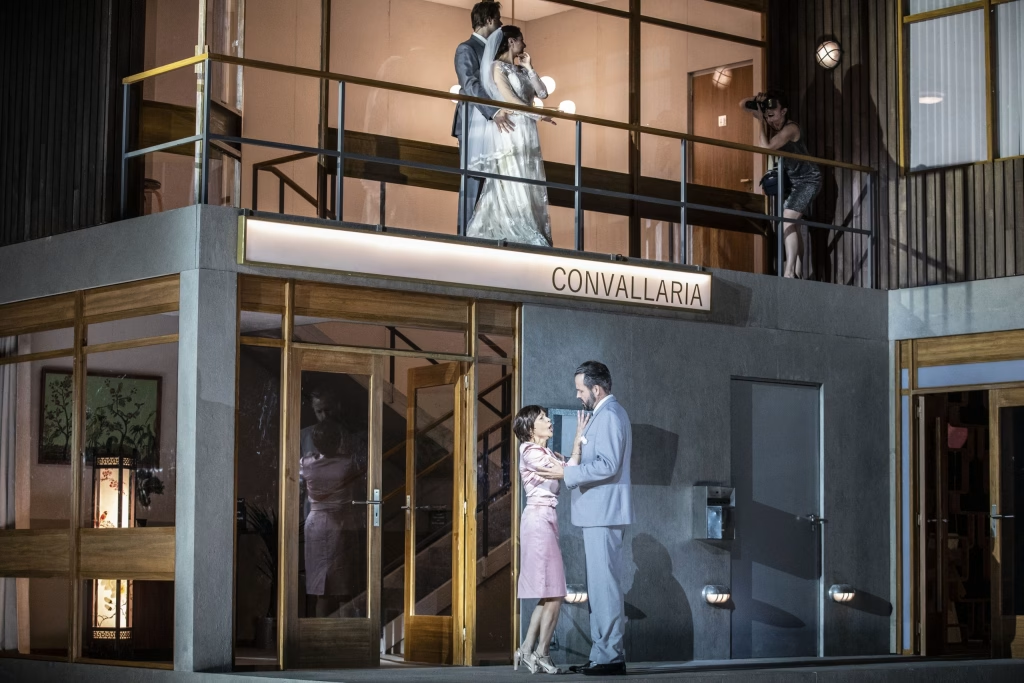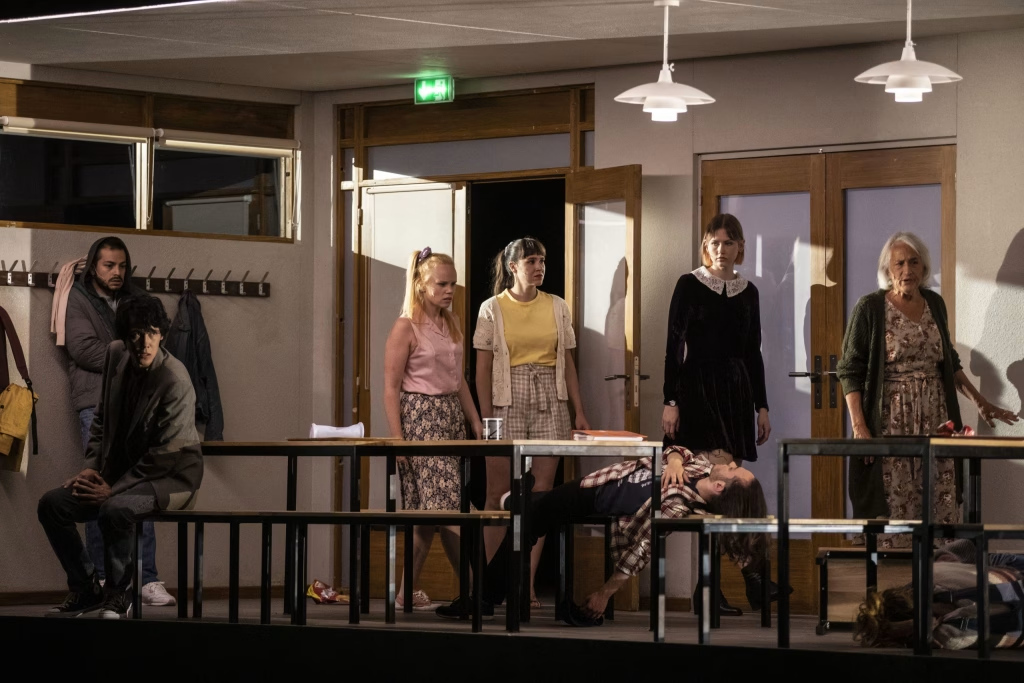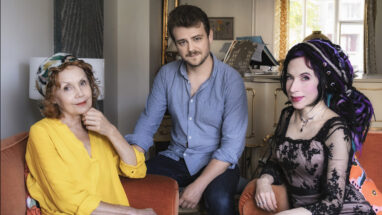”There won’t be much talk of blood here.
You can find that on TV, in movies, or in the newspaper.”
Heinrich Böll, The Lost Honor of Katharina Blum, 1974*
In the spring of 2013, Kaija Saariaho invited Sofi Oksanen and me to dinner. She had received a contact from the Royal Opera House about possibly writing an opera inspired by the contemporary world and was excited by the idea of composing her first work for the stage that would have numerous characters, languages, and perspectives on the same event. Kaija called the project Fresco. For this, she needed a virtuoso storyteller who could approach the diversity of our world through carefully crafted characters, i.e. Sofi. A dramaturge and translator familiar with opera was also needed because Sofi would be writing her first opera libretto, and she would do so in Finnish, whereas the final work would be multilingual. This was how I ended up as a dramaturge-translator at this first dinner trying to find an answer to Sofi’s question: what subject has not yet been dealt with in the opera?
Of course, this question was about more than the allure of novelty. Operas have been written about the full range of human experience: love, jealousy, ambition, gods, tyrants, murderers, rapists, slaves, rebels. To what contemporary phenomenon could we apply the tools of opera to expand our understanding about the ways human beings cause and feel pain, and survive?

Three artists, three generations, three forms of expression. During our discussions, we let the list of possible topics grow in a triangle. Sofi had recently published her novel When the Doves Disappeared, in which Estonian characters survive the Second World War and changes in government by fighting or adapting, lying to others or themselves. Kaija was composing an opera based on a Noh play about a soldier whose traumatized ghost demands a ritual from the living to finally find peace (Only the Sound Remains, 2016). I had just directed a performance of the Kindertotenlieder, which set Mahler’s songs on the death of children in the aftermath of the Sandy Hook elementary school shooting and focused on the grieving of the parents (the conductor and my partner in creating the performance was Clément Mao-Takacs). In our opinion, the new Fresco project was something completely different from our other projects at the time. However, the questions troubling each of us were engaging in a secret conversation like the roots of trees underground. Alongside our discussions, Sofi was working on a new story about the revelation of a hidden crime from the past at a family party and calling it The Uninvited Guest.
Kaija had come up with a formal idea for a group fresco, in the style of Leonardo da Vinci’s Last Supper, and Sofi drew an association between that and wedding photos, where solemn faces conceal hidden family drama. The structure she built is similar to many of her novels—the interaction of two intertwining timelines/narrative levels sets off a series of revelations and gradually enriches our understanding of the characters. The more compact implementation of this familiar arc in this work is, perhaps partly due to the density of the libretto form, one of Sofi’s most refined achievements as an author. The characters of the story grew as my translations were completed and started moving between the three of us via e-mail in the summer of 2016. Sofi polished the text, and Kaija used recordings of the translations to develop a melodic and harmonic language for each character, which the rest of the music for the opera grew out of and wove together with, achieving clockwork precision. Our decision to give certain roles to actors instead of singers enabled both a larger use of text and new ways for Kaija to weave it into the music.

It was no longer just Fresco, an abstract polyphonic form, and not just The Uninvited guest, the dilemma of the individual in relation to a group. We were seeing the birth of Innocence, a drama of thirteen people’s guilt and self-recrimination; each the prisoner of the isolation of their own trauma, while simultaneously bound to the others through their shared trauma. Just like language can isolate people just as much as they unite them. In Innocence, the languages combine the text and music into a new way to explore and describe the complexity and desolation of our world.
When the work was rehearsed for the first time in the summer of 2020 amidst pandemic restrictions, it proved to be especially important, albeit difficult, to build an opera that by its very nature forces artists of different languages and disciplines to come together to create something in common.

So how did this form answer Sofi’s original question about addressing a new topic with the tools of opera? Sofi developed a wonderful answer with her libretto. She used the example of a school shooting and an abundance of roles to show how multifaceted and utterly structural the creation of violence is. A bloody act committed by a young person is always considered, as the libretto says, an ‘inexplicable’ ‘tragedy’. Sofi’s text evokes the superficial public debate that occurred after Columbine and Kauhajoki—there is plenty of talk about youth violence, about the graphic nature of movies and video games, and sometimes about the availability of guns. And of course, these are factors we could address better at a societal level, even if we won’t. However, there are broader questions lying behind all this, and we almost never talk about them at all because they are taboo in our culture. These taboos arise from our rigid understanding of the domain of personal responsibility, about problems that we do not see as societal, such as mental health and the silent violence produced by communities. Everyone struggles alone with the myths of their society. What is a man supposed to be like, or a woman? What does it mean to be a good father or mother? What are you supposed to accept in the name of love? Innocence shows how problematic all our answers to these questions may be if we do not examine our own values and intentions, if we cling vehemently to convenient roles and narratives, without considering the consequences of our decisions. Through the many levels offered by the operatic form, Sofi’s libretto is able simultaneously to present thirteen stories of loneliness and show how they influence each other. Together, these thirteen arcs remind us of the importance of telling/bringing forward hidden stories in public discourse.
In Sofi’s words: ‘Public narratives attach individual subjective meanings to larger cultural and institutional narratives. (…) The sociologist Margaret Somers calls the absence of these stories narrative silence. If an individual does not find a suitable public story for themselves, it is difficult for that individual to build their own subjectivity; what a person knows about life in general is the result of a large number of public narratives, among which it is possible to find oneself and in which one can place one’s current stage of life. But if one’s own life cannot be placed in the public narrative, it is also not possible to recognize one’s own life and experiences in the public narratives that are already available. Such silence hinders the individual’s attempt to build themselves and their identity. There is no mirror to be found anywhere’. (Too Short a Skirt, Bonnier Books, 2011) This reasoning applies to violence against women, but Sofi has also analysed the same mechanisms in her work relative to the suppression of collective history in Estonia (Behind Everything was Fear, WSOY, 2009), and they apply to all trauma and to the position of the individual in the world in general.

Only in a multilingual musical work for the stage is it possible to polyphonically weave together so many stories and so many interactions. However, artistic expression not only has a responsibility to present public narratives and our struggles with them; another key question is how they should be presented. According to studies, school shooters revel in the images created by the film industry on the topic, just as all the armies of the world enjoy watching and quoting battle scenes even from pacifist war films. How can art avoid tolerating, normalizing, or even increasing the incidence of violence while simultaneously depicting it? In the development phase of Innocence, the earliest and perhaps most radical decision was to exclude all physical violence, the shooting, and even the shooter himself from the show, and focus on the stories and voices that receive less visibility. Gunshots and blood belong to the entertainment genre, a genre that does not allow space for the symptoms and time of trauma. Innocence is dominated by the psychological time of trauma and its repression. Kaija’s music has achieved something very original, from which even action films could take a lesson: the recognition that the logic of dreams can be more exciting than a thriller.
The director of this first production of Innocence, Simon Stone, has, along with choreographer Arco Renz, developed a beautiful way of giving a central role to trauma as a physical reality. As a skilled creator of images, he has also tried to tease the viewer’s expectations of showing violence, and part of his process has been to carefully dose the physical violence and appearance of the shooter. It would be interesting to see a production in the future that fully adopts the distinguishing principle of the work, and completely rejects blood and the shooter as a character, without giving a centimetre of ground to the macabre fascination that the mass media has cultivated in us. As an art form, theatre has an obligation not only to critique mainstream images but also to develop new images that are lacking in the homogenized public space.
For its creators, Innocence has been a continuation of our previous work and its climax. Above all, we hope it will be the start of many new ways of telling all the stories, and to many difficult and necessary conversations.
*Böll’s novel, subtitled ‘How violence develops and where it can lead’, was a central part of the work Violences performed at the National Opera in 2019 (dram. & dir. A. Barrière, cond. C. Mao-Takacs).
Text ALEKSI BARRIÈRE, dramaturge and translator of Innocence
Photo of Kaija Saariaho, Aleksi Barrièren and Sofi Oksanen TONI HÄRKÖNEN, production photos JEAN LOUIS FERNANDEZ, Festival d’Aix-en-Provence
The premiere of Innocence will take place on 21 October 2022 at the Finnish National Opera.


